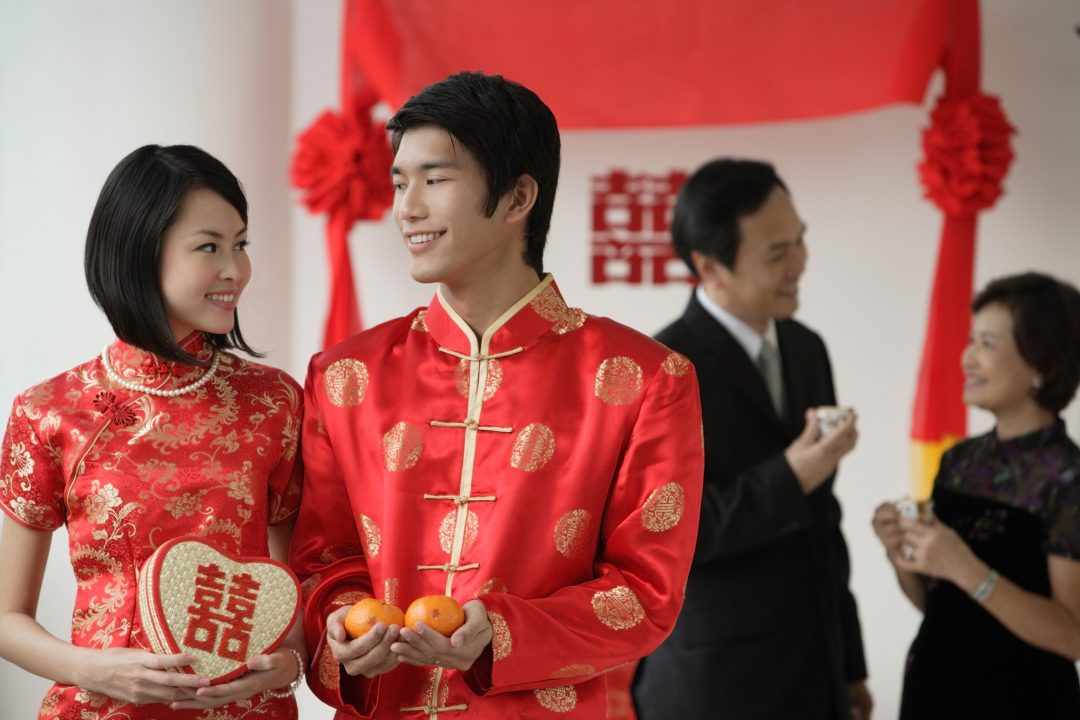
Despite traditional Chinese weddings being associated with all things flashy, colourful and exciting—behind its exterior holds a much deeper meaning and significance to it.
While today’s nuptials are largely modernised and no longer involve a long and large procession, a traditional Chinese wedding is still one that focuses on familial ties and bestowing an abundance of blessings to the loving couple.
Especially if you have parents or in-laws who are a stickler for tradition, hosting a wedding that features some of the most significant Chinese wedding customs is a sure way to satisfy everyone and give special meaning to your ceremony.
Just a heads up: a traditional Chinese wedding will require a lot of planning and preparation, which is why we have prepared a guide to help you get ready for yours!
Because honouring one’s traditions will never go out of style.
1. Setting an auspicious date
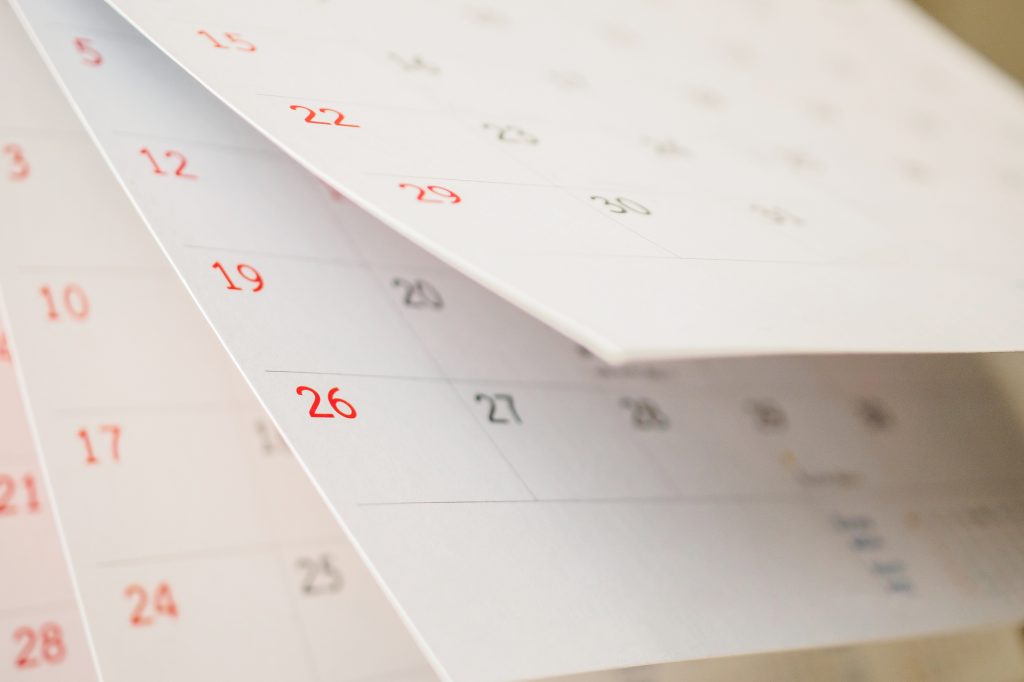
Couples of Chinese heritage often consult a fortune teller, Chinese monk or Feng Shui master to select an auspicious date for the wedding, according to their unique 8 Characters (八字) that takes into account their Chinese names, zodiac signs, birth dates, and even birth timings.
The seventh month of the Lunar calendar is often avoided as it falls on the month of the Hungry Ghost Festival which is deemed to be unlucky for the marriage.
Although many couples end up choosing a date that fits in with their hectic schedule, choosing an auspicious wedding date is a great way to add meaning and kickstart a new chapter with your partner.
2. Asking for hand in marriage (提亲)
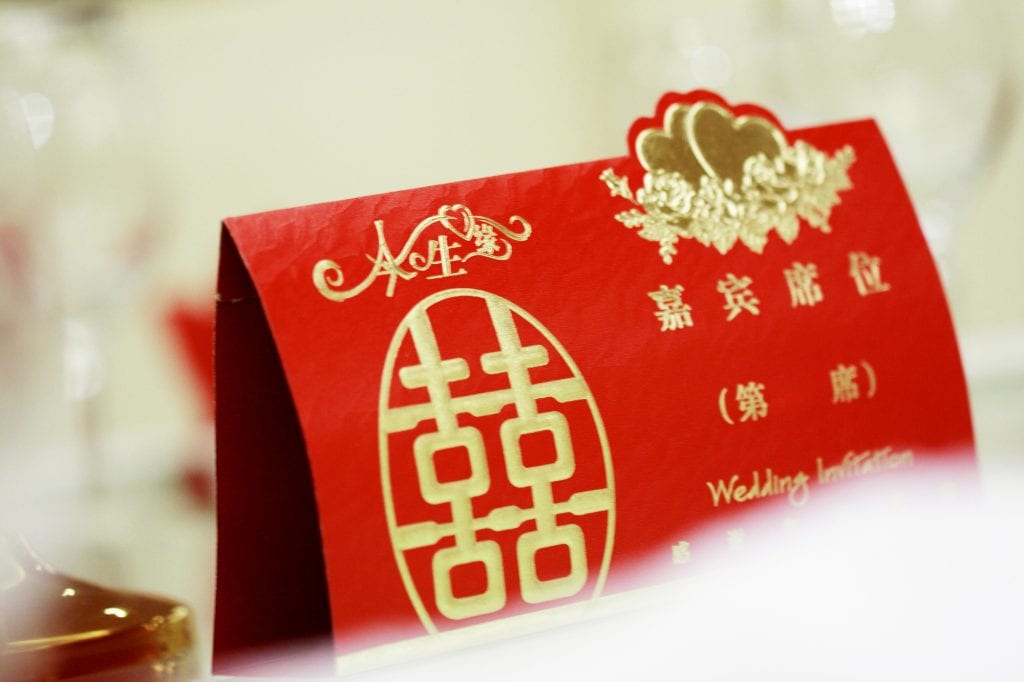
On the day itself, both you and your partner should be dressed in proper attire and the groom should prepare some gifts beforehand to express his sincerity.
This is also a good time to discuss the details of the wedding with your in-laws to avoid any unpleasant confrontations later on.
3. The Guo Da Li (过大礼) ceremony
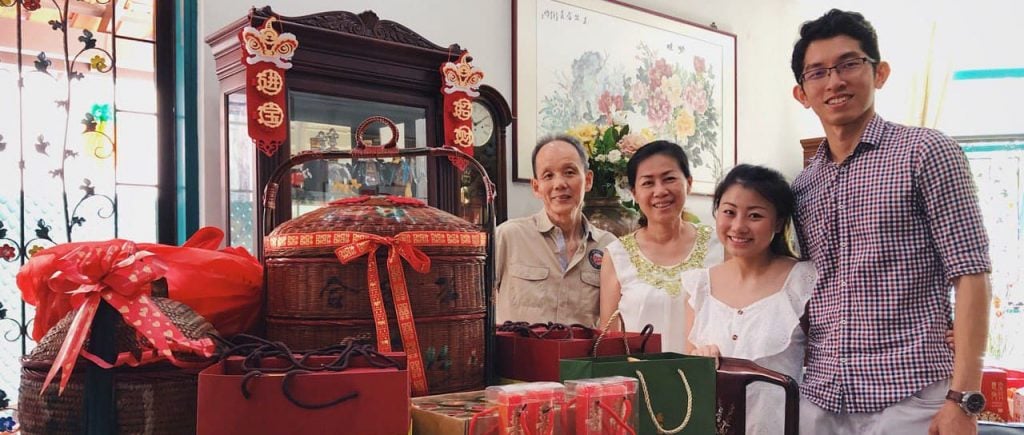
This is the first formal meeting between the bride’s and groom’s families and is usually held two to four weeks before the wedding.
Depending on your dialect group, the groom and his parents will present the bride’s parents with a basket of gifts containing unique items.
For your convenience, we have created a checklist for common dialect groups found in Singapore: Cantonese, Teochew, Hakka, and Hokkien.
Each item signifies good fortune, abundance and prosperity and is intended to be a formal proposal to the bride’s parents. Ideally, the gifts are presented in even numbers and placed in a traditional tiered wedding basket.
To return the gesture of goodwill, the bride’s family will then return a portion of the gift and present the groom’s family with the Bride’s Dowry (嫁妆) as an acceptance of the proposal and to express their well-wishes for the couple.
The dowry consists of personal items like a set of new clothes to symbolize a lasting union, a wallet with a red packet for wealth, a tea set that is used for the tea ceremony and household items for the couple to start a new family.
After the ceremony is complete, the couple is now considered officially engaged!
4. The Gifting of Si Dian Jin (四点金)
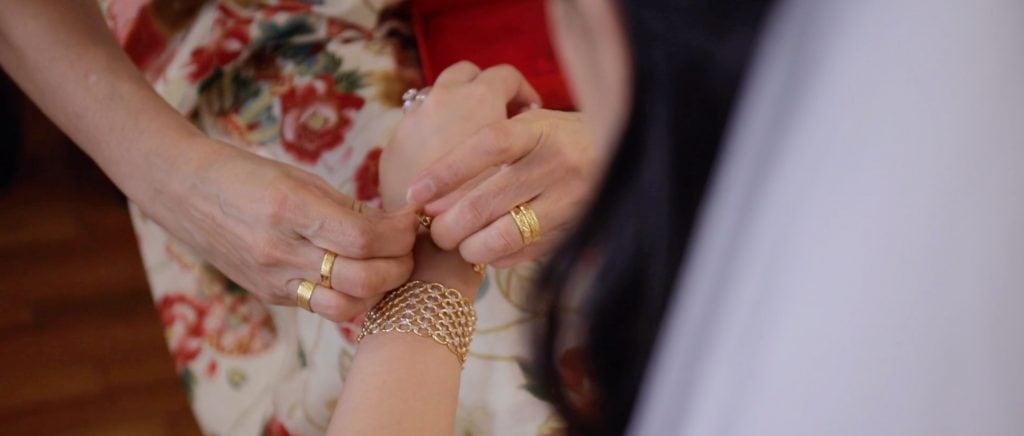
Translating to “four touches of gold” in Mandarin, it consists of a necklace, a pendant, a pair of earrings and a bangle; although Cantonese and Hokkien families may focus only on gifting two gold or jade bangles.
The jewellery often incorporates one or more of these motifs: a Dragon and Phoenix to symbolize a match made in heaven and perfect harmony between the couple, flowers to represent the bride’s beauty and the double happiness characters (双囍) to signify a lifetime of bliss and happiness.
Many brides prefer their Si Dian Jin to match with their personal style, which is why many jewellers offer modernized versions including yellow gold, pearl and rhinestone options.
Nonetheless, the gifting of Si Dian Jin represents the groom’s promise to take good care of the bride and the family’s acceptance of the bride into the family. For most families, the Si Dian Jin is a prized heirloom that can also be passed down through generations.
5. The An Chuang (安床) Ceremony
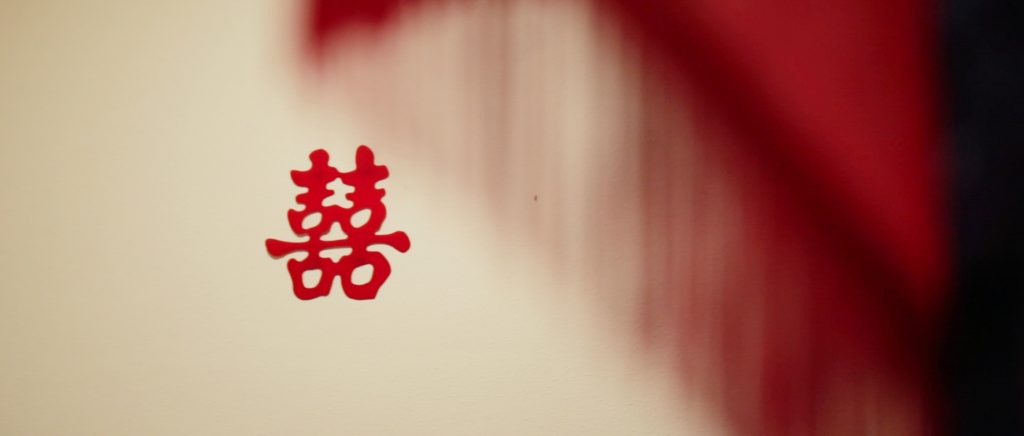
It is usually held on an auspicious time and date that is calculated by a Feng Shui master, although it can be held anytime between two days to a week before the wedding.
Depending on your dialect, the ceremony will be conducted by different people—Cantonese and Hakka families will pick a woman of good fortune (one blessed with parents, husband, children and grandchildren) to set the bed while Teochew and Hokkien families prefer the groom’s mother, father or grandfather to do so.
During the ceremony, the matrimonial bed is dressed in brand-new red or pink linen and pillows and a plate containing dried longans, lotus seeds, candy, lily bulbs, persimmons, red dates and a sprig of pomegranate leaves together with 2 red packets of money and 2 oranges is placed on top of the bed.
The list may sound tedious, but all these items are believed to bestow the couple with an everlasting union, good fortune, fertility and many years of sweetness!
Don’t forget to also prepare a pair of bedside lamps which holds the same meaning as adding descendants to the family, keeping them on for at least 3 days after the ceremony.
Fate coins (大缘小缘) are also placed at all four corners of the bed, cupboard and drawers. To end off the ceremony, everyone will chant the following four phrases to bless the couple with a happy, long-lasting marriage:
百年好合 (May you be blessed with a blissful and harmonious marriage for a century)
早生贵子 (May you be blessed with plenty of children quickly)
白头偕老 (May you grow old together)
永浴爱河 (May you always be filled with love for one another)
No one is allowed to sit or sleep in the bed until after the wedding, where a young boy is then invited to roll on the bed—all in the name of blessing the couple with an abundance of children!
6. The Hair Combing (上头) Ceremony
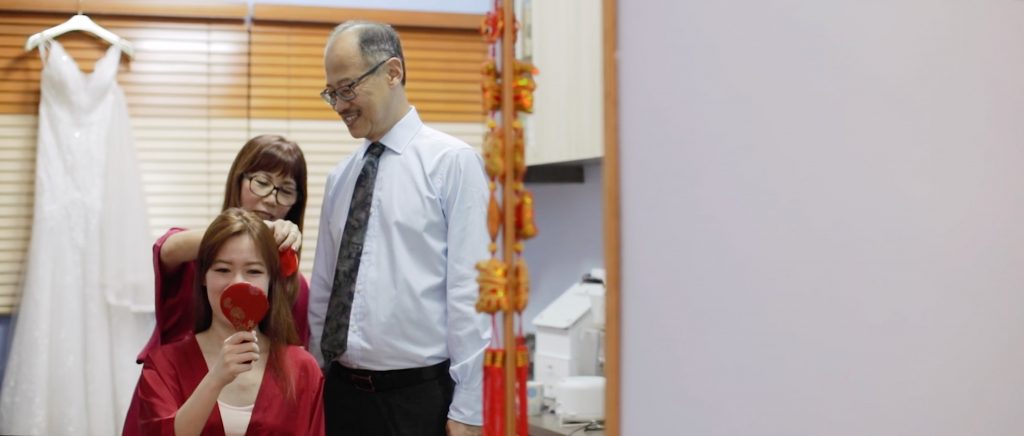
Taking place on the eve of the wedding day, the couple is asked to shower with pomegranate or pomelo leaves to cleanse off any bad spirits and change into a new pair of pyjamas and bedroom slippers.
The bride will then sit in front of a mirror, while the groom sits facing the inside of the house. Typically conducted by the parents of the bride and groom, they will each prepare a pair of red taper candles and scissors, one stick of incense, a wooden ruler, a hair comb, red yarn and some Thuja leaves.
Upon lighting a pair of red taper candles, each parent will proceed to comb the hair of the bride and groom in four strokes while reciting the following:
一梳梳到尾 (May your marriage last for a lifetime)
二梳百年好合 (May you be blessed with a happy and harmonious marriage)
三梳子孙满堂 (May you be blessed with an abundance of children)
四梳白发齐眉 (May you be blessed with longevity)
After this, a red string is then tied on the bride’s hair or kept in the groom’s pocket to signify the end of the ceremony. For sweet endings, the couple is then served a bowl of pink glutinous rice balls to symbolize a complete and loving marriage.
7. Fetching of the bride (接新娘/迎亲) and Gatecrashing (闯门)
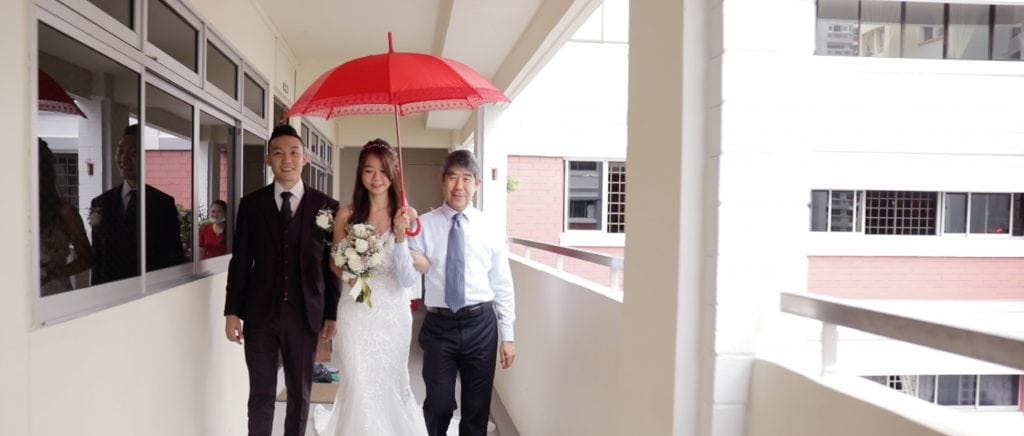
The groom can’t arrive empty-handed and will have to prepare a list of items—typically a roast pig to thank the parents for bringing up the bride, a red packet, 18 oranges for good fortune, some dried longan for a loving marriage and two bottles of wine among other things.
This leads up to probably one of the most memorable and exciting parts of the day—the gatecrashing or “door games” which originated from the idea that the bride is a precious gem of the family and the family’s reluctance in letting her go.
Fun fact: nobody actually knows where the tradition of gatecrashing came from, although most theories suggest that it is a lot more of a modern practice than it is a long-established tradition. What we do know, however, is that people love it anyway!
To test if the groom is worthy of the bride, the bridesmaids prepare a series of games for the groom and his groomsmen to prove his sincerity and earn the approval of the family. The challenges vary from pushups, trivia questions, giving out red packets to eating a blend of sweet, sour, spicy and bitter foods—all in the hopes that the bridesmaids will “surrender” the bride to the groom.
Once he has passed the test, the groom then proceeds to find the bride and escort her to the bridal car to his place for the tea ceremony.
Before setting off in the bridal car, the bride is often sheltered with a red umbrella that is believed to ward off bad spirits. She then proceeds to throw out a red foldable fan through the car window to signify leaving all negativity in the past as she begins a new chapter in a smooth-sailing marriage.
8. The Chinese Tea Ceremony (敬茶)
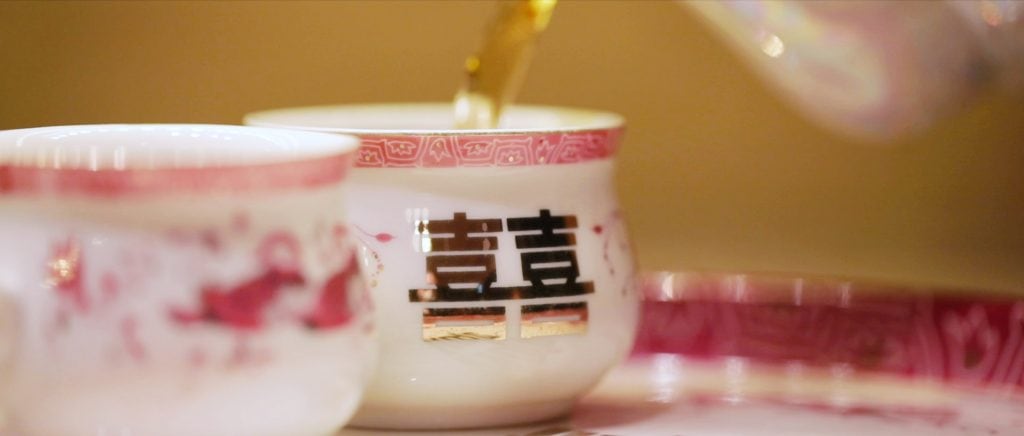
This is the perfect demonstration of family values and filial piety where the bride and groom express their deepest respects, gratitude and appreciation for their parents’ love and support in raising them.
One thing for couples to remember: don’t remove your shoes upon entering the house! It is believed that the bride and groom should wear their shoes at all times to ensure a prosperous life after their nuptials.
A red tea set with a double happiness symbol is usually prepared for the tea ceremony where black or green tea is sweetened with dried longans, lotus seeds and red dates and then served to the elderlies.
The bride also dons on a traditional Chinese wedding dress known as the Kua—an exquisite two-piece set that is made of red fabric embellished with colourful threads, sequins, pearls and gold and silver embroidery featuring a Dragon and Phoenix in the front. The dress may also feature peonies, lotus flowers and animals like birds, butterflies and goldfishes (in pairs of course!)
One of the bridesmaids will help prepare the teacups as it needs to be rinsed in a basin of hot water and refilled for the next relative. The couple proceeds to kneel or bow to the groom’s parents, asking them to “please drink the tea,” followed by the rest of the elders according to seniority.
The bride has to make sure that she is seated to the right of the groom and that the tea is always served with both hands. Each relative will present a red packet to the couple after drinking the tea as a form of sending their well-wishes to the couple and as an official welcome to the family.
9. The Wedding Banquet (喜酒)
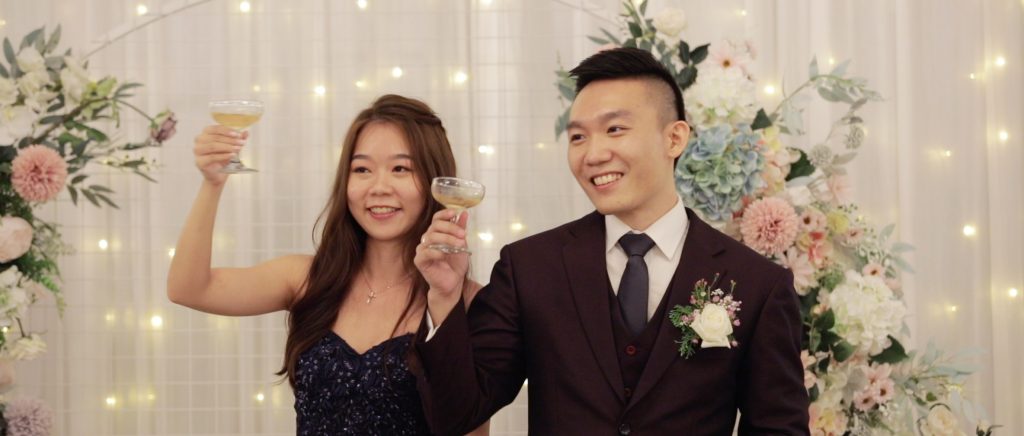
Whereas the Chinese tea ceremony is often intimate and only for both families, the wedding banquet is for hosting the friends and extended families of the couple.
Often held in a hotel ballroom, the guests are first asked to sign-in and write down their best wishes to the couple in a guestbook.
It is also customary for guests to prepare a red packet—containing a sum preferably in even numbers and the number 8, as well as avoiding any amount ending in 4s to help cover the cost of the banquet seat and as a form of blessing to the newlyweds.
The couple’s guests are then treated to a sumptuous feast featuring a six to eight-course meal that consists of symbolic, auspicious foods like fish for abundance, a suckling pig to signify the bride’s purity and a sweet lotus seed dessert for fertility. Peking duck, abalone, scallops and noodles are also popular items on the menu.
Most modern Chinese weddings will hire a professional emcee to host their banquet and entertain the guests. After exchanging their vows on stage and somewhere between the third and sixth course, the bride usually changes into a qipao and the couple proceeds to go around each table to greet their guests and thank them for being a part of their celebration.
To end things off on a high note, the guests are invited to stand up and engage in a “yam seng” toast at the end of the reception. Translated from Cantonese as “Cheers to Victory,” friends and relatives will stand up and shout for as long as possible to shower the couple with love and well-wishes before they head home.
Do take note that due to governmental regulations in Phase 3, the number of guests and activities that you can have at your banquet is limited.
10. 3 Days After (三朝回门)
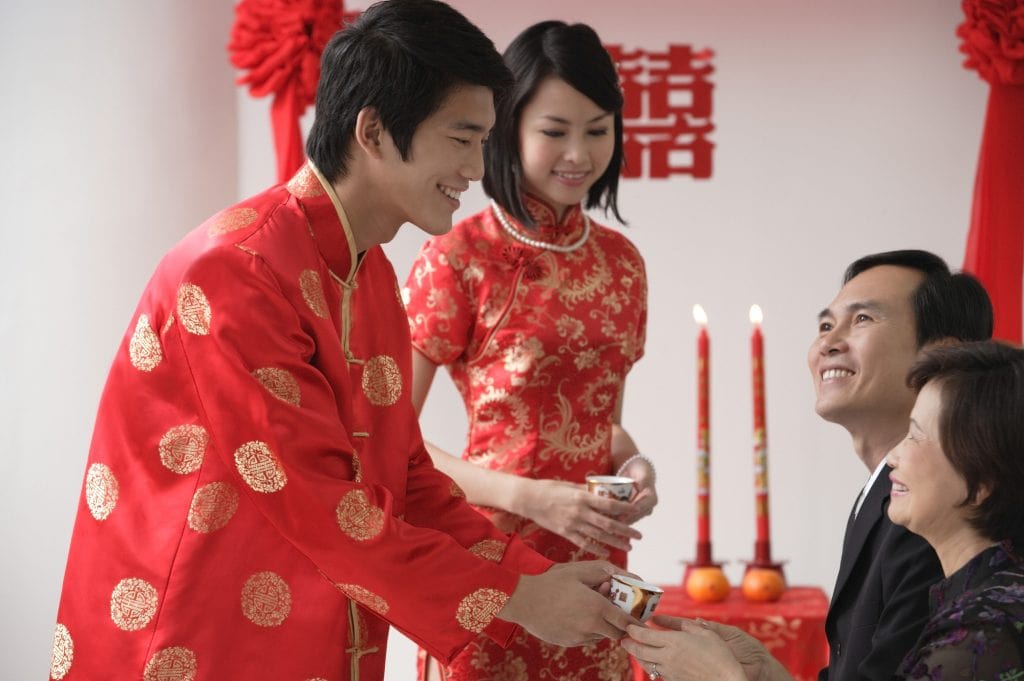
However, most couples today prefer to squeeze this into the same day as the wedding, returning to the groom’s house straight after the tea ceremony. Before returning home, the bride will simply change into a new gown to symbolize the passing of 3 days.
Traditionally, the couple is supposed to prepare a roasted pig, two chickens, lettuce, cakes, two bottles of wine and other gifts for the bride’s family. To simplify things, these gifts are usually replaced with red packets in modern ceremonies.
The bride’s family will then return part of the roasted pig by dividing it into 3 portions (head, middle and tail), gifting the head and tail to the groom’s family to symbolize the start and end of the marriage (有头有尾)
A similar tea ceremony and simple wedding banquet will also be thrown to celebrate the newlyweds and for the couple to thank their family and relatives for their blessings.
Keep your traditions alive with a timeless highlight reel
With 2021 wedding trends seeing more meaningful micro-weddings, enhanced guest experiences and sustainability coming into play, couples can choose to tweak and scale back some of these Chinese wedding customs to match their preferences.
As part of keeping your traditions alive, why not consider capturing each moment in a timeless highlight reel that you can cherish for decades?
TNC Weddings is a professional team made up of creatives and wedding videographers that are dedicated to encapsulating your big day into a timeless and heartfelt video.
Using modern technology and classic filmmaking techniques, our actual day wedding videography videos are designed to express your unique love story — all you have to do is share your ideas with us and enjoy your wedding day to the fullest!
